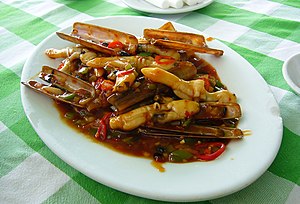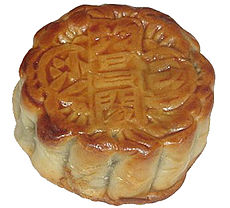Chinese cuisine/ja: Difference between revisions
Created page with "==食事作法{{Anchor|Dining etiquette}}== {{Main/ja|Customs and etiquette in Chinese dining/ja}} thumb|宋代(10世紀〜13世紀)の銀器:箸、碗、匙 若者は年長者より先に食事を始めてはならない。碗から食べる際、底の部分を持ってはならない。それは物乞いの行為に似ているためである。箸は中華料理の主要な食事用..." |
Created page with "米を主食にするか、パンや麺のような小麦粉から作られた食事を主食にするかによって、同じ文化圏の人々や異なる背景を持つ人々は、相手の出身国が中国南部か北部かを推測することができる。異なる食べ物には異なる象徴的な意味がある。月餅と餃子はそれぞれ中秋節と春節を象徴している。梨..." Tags: Mobile edit Mobile web edit |
||
| (4 intermediate revisions by the same user not shown) | |||
| Line 276: | Line 276: | ||
若者は年長者より先に食事を始めてはならない。碗から食べる際、底の部分を持ってはならない。それは物乞いの行為に似ているためである。[[Chopsticks/ja|箸]]は中華料理の主要な食事用具であり、食べ物を切ったり掴んだりするのに使える。食卓で休憩する際、箸を垂直に米に立ててはならない。これは、箸を米の碗の中に垂直に立てる中国の伝統的な葬儀の供物と似ているためである。食卓でナイフを使用することは不適切と見なされる。箸を空中で振り回したり、弄んだりしてはならない。食べ物はまず目の前の皿から取るべきである。皿をじっと見つめることは無作法と見なされる。食事中にテレビを見たり、携帯電話を使ったり、他の活動をしたりすることは趣味が悪いと見なされる。年長者が若者の碗に食べ物を入れた場合、若者は感謝すべきである。 | 若者は年長者より先に食事を始めてはならない。碗から食べる際、底の部分を持ってはならない。それは物乞いの行為に似ているためである。[[Chopsticks/ja|箸]]は中華料理の主要な食事用具であり、食べ物を切ったり掴んだりするのに使える。食卓で休憩する際、箸を垂直に米に立ててはならない。これは、箸を米の碗の中に垂直に立てる中国の伝統的な葬儀の供物と似ているためである。食卓でナイフを使用することは不適切と見なされる。箸を空中で振り回したり、弄んだりしてはならない。食べ物はまず目の前の皿から取るべきである。皿をじっと見つめることは無作法と見なされる。食事中にテレビを見たり、携帯電話を使ったり、他の活動をしたりすることは趣味が悪いと見なされる。年長者が若者の碗に食べ物を入れた場合、若者は感謝すべきである。 | ||
中国文化には、食べ物がどのように、いつ食べられるかについての指針がある。中国人は通常、朝食、昼食、夕食からなる1日3回の食事を摂る。朝食は午前6時から9時頃、昼食は午後12時から2時頃、夕食は午後6時から9時頃に提供される。深夜の4回目の食事は[[:en:siu yeh|消夜]]として知られ、午後9時から午前4時まで提供され、これは西洋の[[supper/ja|夜食]]の概念に似ている。中国文化の中では、家族は異なる伝統に従う。一部の家族では、年長の家族と若者が先に食事をし、次に母親と父親、そして子供とティーンエイジャーが食事をする。他の家族では、男性と女性が別々の席で食事をする。家族がどのような伝統に従うにしても、それは家族のメンバーに敬意を示すことを目的としている。 | |||
==中国哲学と宗教との関係{{Anchor|Relation to Chinese philosophy and religion}}== | |||
== Relation to Chinese philosophy and religion == | [[File:Mooncake1.jpg|thumb|upright|[[Mooncake/ja|月餅]]、中秋節に食べられる]] | ||
[[File:Mooncake1.jpg|thumb|upright|[[Mooncake]] | 食べ物は社会文化生活において様々な役割を果たす。[[:en:Chinese folk religion|中国の民間信仰]]では、[[:en:Ancestor veneration in China|祖先崇拝]]は祖先に食べ物を供えることによって行われ、中国の祭りでは象徴的な意味を持つ特定の食べ物の消費と準備が伴う。中国の特定の宗教には、[[Taoist diet/ja|道教の食事]]、[[Buddhist cuisine/ja|仏教料理]]、[[Chinese Islamic Cuisine/ja|中国イスラム料理]]など、独自の料理がある。 | ||
[[:en:Henan|河南省]][[:en:Kaifeng Jews|開封]]のユダヤ人はかつて独自の中国ユダヤ料理を持っていたが、現代ではそのコミュニティはほとんど消滅し、彼らの料理の具体性についてはあまり知られていない。しかし、彼らはその地域で食べられる食品に影響を与え、彼らの料理の一部は残っている。開封ユダヤのルーツがあるとされる中華料理には、開封小籠包、馬豫興桶子鶏、菊花鍋、四喜丸子などがある。 | |||
食料は日常生活においても役割を果たす。食事の場の形式は人々の関係性を表し、食べ物の種類はその人の社会的地位や出身国を示すことができる。正式な場では、客に敬意を表すために、温菜と冷菜を合わせて最大16品が供される。一方、カジュアルな場では、屋台の食べ物や家庭料理のような安価な食事が提供される。中国社会における富裕層とそれ以下のグループの間の典型的な食料の格差は、フカヒレや熊の掌のような食べ物や食材の希少性とコストにある。 | |||
米を主食にするか、パンや麺のような小麦粉から作られた食事を主食にするかによって、同じ文化圏の人々や異なる背景を持つ人々は、相手の出身国が中国南部か北部かを推測することができる。異なる食べ物には異なる象徴的な意味がある。[[Mooncake/ja|月餅]]と[[dumpling/ja|餃子]]はそれぞれ[[:en:Mid-Autumn Festival|中秋節]]と春節を象徴している。[[Pear/ja|梨]]は、母国語で「離れる」という発音に似ているため不運を象徴し、麺はその長さから長寿を意味する。 | |||
<div lang="en" dir="ltr" class="mw-content-ltr"> | <div lang="en" dir="ltr" class="mw-content-ltr"> | ||
Latest revision as of 20:45, 15 June 2025

| 下記のシリーズの一部 |
| 中華料理 |
|---|
 |
|
|
| Culture of China |
|---|
 |
| Mythology and folklore |
| Cuisine |
| Festivals |
| performing arts |
中華料理は、中国および世界各地の華僑に起源を持つ料理である。中国人の離散と国の歴史的な力により、中華料理はアジア内外の多くの他の料理に深く影響を与え、現地の味覚に合わせて変更が加えられてきた。米、醤油、麺、茶、ラー油、豆腐といった中華料理の主食や、箸、中華鍋といった調理器具は、現在では世界中で見られる。
高熱を必要とし、現代中華料理でしばしば使われる炒める技法は、後の中国王朝である北宋時代になって初めて急速に発展した。唐代には屋台料理が中国の食文化の不可欠な要素となり、19世紀後半に中国から輸入された労働者によって東南アジアの多くの地域の屋台料理文化が確立された。
中国の省における調味料や調理法の好みは、社会階級、宗教、歴史的背景、民族集団の違いに依存する。中国の気候が南部では熱帯から北東部では亜寒帯まで変化することを考慮すると、山、川、森林、砂漠などの地理的特徴も、地元で入手可能な食材に強い影響を与える。宮廷の王族や貴族の好みも中華料理の変化に影響を与えている。帝国の拡大、移民、貿易により、他の文化の食材や調理法が時間とともに中華料理に統合され、中国の料理の影響は世界中に広まっている。
中国文化は周辺地域にも広がり、日本料理、韓国料理、ベトナム料理などは中華料理から強い影響を受けてきた。また、海外の中国人が移住先の国に中華料理を持ち込んだため、東南アジア、北米、南米、ヨーロッパなどでも普及し、現地化も進んでいる(日本式中華料理、アメリカ式中華料理など)。
中華料理は海外に大きな影響を与えてきた一方で、中華料理の技法も日本料理を含む外国の料理から大きな影響を受けており、中華料理が独自の発展を遂げた例も少なくない。その一例として、大きな大皿に盛られた料理を分け合うスタイルから、フランス料理のようにコース仕立てで一人分ずつ提供される「新中華高級料理」がある。これは、現代的で洗練された食材や調理法を取り入れ、進化してきたものである。
中国国内外には、地域、宗教、民族による数多くの中華料理のスタイルが存在する。中華料理は非常に多様であり、最も頻繁に省ごとの区分に分類されるが、これらの省レベルの分類自体もさらに多くのスタイルを含んでいる。清代には、中華料理で最も称賛された四大料理は、それぞれ西、北、南、東中国の料理を代表する川菜、魯菜、粤菜、淮揚菜であった。1980年、中国のジャーナリスト王紹泉が人民日報に発表した記事による現代の分類では、中国八大料理として、安徽(徽菜; Huīcài)、広東(粵菜; Yuècài)、福建(閩菜; Mǐncài)、湖南(湘菜; Xiāngcài)、江蘇(蘇菜; Sūcài)、山東(魯菜; Lǔcài)、四川(川菜; Chuāncài)、浙江(浙菜; Zhècài)が挙げられている。

中華料理は、中医薬膳の実践のように、伝統的な中国医学と深く結びついている。色、香り、味は、中華料理を表現するために用いられる3つの伝統的な側面であり、料理の意味、見た目、栄養も同様である。料理は、使用される食材、包丁さばき、調理時間、調味料に関して評価されるべきである。
歴史
唐以前



中国社会は美食を高く評価し、伝統的な医学的信念に基づいたこの主題の広範な研究を発展させた。中国文化は当初、華北平原を中心に展開していた。最初の栽培作物はアワとキビの品種であったようだが、稲は南部で栽培されていた。紀元前2000年までに、小麦が西アジアから伝来した。これらの穀物は通常、ヨーロッパのようにパンに焼かれるのではなく、温かい麺スープとして供された。貴族は様々な野生の獲物を狩り、羊肉、豚肉、犬肉を消費した。これらの動物は家畜化されていたためである。穀物は飢饉や洪水に備えて貯蔵され、肉は塩、酢、燻製、発酵によって保存された。肉の風味は動物性脂肪で調理することによって高められたが、この習慣は主に富裕層に限られていた。
孔子が戦国時代後期に活躍した頃には、美食は高度な芸術となっていた。孔子は食事の原則について論じている。
米は白すぎず、肉は細かすぎないのがよい。…きちんと調理されていなければ、人は食べない。まずければ、人は食べない。肉が適切に切られていなければ、人は食べない。適切なソースで調理されていなければ、人は食べない。肉は豊富にあるが、主食以上に調理すべきではない。酒に量的な制限はないが、人が酔い潰れる前でなければならない。
『呂氏春秋』には、「天子に選ばれて初めて、最も美味な珍味が用意される」と記されている。
招魂(紀元前4〜3世紀)にはいくつかの例が挙げられている。スッポンのラグー、蜂蜜ケーキ、ビール(氷で冷やしたもの)などである。
始皇帝の秦代には、帝国は南へと拡大した。漢代までには、中国の様々な地域と料理は主要な運河によって結ばれ、様々な地方料理の複雑性が増した。食べ物は「気」、すなわちエネルギーを与えるものと見なされるだけでなく、陰陽を維持することにも関わるとされた。その背後にある哲学は『易経』と中国伝統医学に根ざしており、食べ物は色、香り、味、食感で判断され、良い食事は四気(「熱」、温、涼、「冷」)と五味(辛、甘、酸、苦、鹹)のバランスが取れていることが期待された。塩は古くから保存料として使用されたが、料理には醤油の形で加えられ、食卓では加えられなかった。
後漢時代(2世紀)までには、作家たちは燻製肉やローストを食べながら一日中座っているだけの怠惰な貴族について頻繁に不平を漏らしていた。
漢代には、中国人は干し肉への肉の乾燥や、穀物の調理、焙煎、乾燥といった軍事行動中の食料保存方法を発展させた。 中国の伝説によれば、焼いて平らにしたパンである焼餅は、漢代の将軍班超によって『西域』(中央アジアの呼称)から持ち帰られたもので、元々は胡餅(胡餅、文字通り「蛮族のパン」)として知られていたという。焼餅は胡餅の子孫であると信じられている。焼餅は、ペルシャのナンや中央アジアのナン、そして中東のピタと関連があると考えられている。唐代には、外国の西洋人が中国でゴマのケーキを作り、販売していた。
南北朝時代には、北魏の鮮卑のような非漢民族が彼らの料理を北中国に導入し、これらの影響は唐代まで続き、漢民族の間でも羊肉のような肉や、山羊の乳、ヨーグルト、馬乳酒のような乳製品が普及した。漢民族が乳製品を嫌うようになり、以前導入された乳製品を放棄したのは宋代になってからである。
南斉から逃れて鮮卑の北魏に亡命した漢民族の反乱者、王粛は、当初は山羊の乳のような乳製品や羊肉のような肉を食べることができず、代わりに茶と魚を摂取しなければならなかったが、数年後にはヨーグルトと羊肉を食べられるようになり、鮮卑の皇帝は彼に中国(中国)の食べ物でどちらが好きか、魚か羊肉か、茶かヨーグルトかを尋ねた。
唐以降
宋代以前および宋代の侵攻時における中国人の南方への大移動により、米やおかゆといった南方中国の主食の相対的な重要性が増した。蘇軾は東坡肉として豚の角煮を改良した。この時期には食習慣や料理習慣も大きく変化し、醤油や中央アジアの影響を受けた食品など、多くの食材が普及し、『山家清供』(Chinese: 山家清供; pinyin: Shānjiā qīnggòng)や『呉氏中饋録』(Chinese: 吳氏中饋錄; pinyin: Wúshì zhōngkuìlù)といった重要な料理書が作成され、当時の難解な料理や一般的な家庭料理がそれぞれ紹介されている。
元と清の王朝はモンゴル料理と満州料理を導入し、火鍋料理を普及させた温かい北方料理である。元代には多くのイスラム教徒のコミュニティが中国に出現し、現在では回族料理店によって全国に保存されている豚肉を使わない料理を実践した。モンゴル料理、特にモンゴルビーフは世界的に人気があるが、モンゴル国外で生まれたものである。モンゴルビーフは1950年代に台湾で、モンゴルバーベキュー風料理の台頭に触発されて作られた。モンゴルビーフはフュージョン料理の完璧な例である。雲南料理は、白族によって作られる乳扇や乳餅のようなチーズ、そしてヨーグルトが中国で独自のものである。ヨーグルトは元代のモンゴルの影響、雲南への中央アジア人の定住、そしてインドやチベットが雲南に近接し影響を与えたことの組み合わせによるものかもしれない。
コロンブス交換の最終段階として、スペインとポルトガルの貿易商は広州やマカオの港湾都市を通じて新世界の食料を中国に導入し始めた。メキシコの唐辛子は四川料理に不可欠な食材となり、カロリー密度の高いジャガイモやトウモロコシは北部の平野全体で主食となった。
清朝時代、袁枚のような中国の美食家たちは、それぞれの食材の風味を最大限に引き出すという主要な目標に焦点を当てた。しかし、彼の料理書『随園食単』に記されているように、当時の料理の流行は非常に多様であり、場合によっては華美に誇示的であった。特に満漢全席のように、その見せ方が正式な儀式の目的も兼ねていた場合はそうであった。
現代中国では生活のペースが速まるにつれて、炒麺、炒飯、蓋飯(ご飯の上に具を乗せたもの)のようなファストフードがますます人気を集めている。
地域料理


中華料理は、地域によって非常に多様な特徴を示す。数多くの異なるスタイルが中華料理を構成するが、おそらく最も有名で影響力のあるものは、広東料理、山東料理、江蘇料理(特に淮揚料理)、そして四川料理であろう。これらのスタイルは、資源の利用可能性、気候、地理、歴史、調理法、生活様式などの要因によって互いに区別される。
あるスタイルは唐辛子やスパイスよりもニンニクやエシャロットの使用を好み、別のスタイルは他の肉や家禽よりも海鮮の調理を好む。江蘇料理は煮込みやシチューのような調理法を好む一方、四川料理は焼くことを採用している。浙江料理は新鮮な食材を提供することに重点を置き、福建料理は海鮮やスープ、スパイスの使用で有名であり、湖南料理は辛くて塩辛い味で有名であり、安徽料理は珍しい味のために野生の食材を取り入れている。
使用される原材料や食材、調理方法、文化的な違いに基づいて、国内の様々な地域で異なる風味や食感を持つ様々な食品が調理されている。多くの伝統的な地域料理は、乾燥、塩漬け、漬物、発酵などの基本的な保存方法に依拠している。
さらに、「米理論」は中国北部と南部の文化的な違いを説明しようとする。北部では小麦が広く栽培されているため麺類がより多く消費されるのに対し、南部では歴史的に米がより多く栽培されてきたため米がより好まれている。
主食
中国の祖先は、約8,000年から9,000年前にアワや稲などの穀物の栽培に成功した。もう一つの主食である小麦は、さらに3,000年から4,000年かかった。初めて穀物が人々に安定した食料供給をもたらした。様々な食料の不足のため、中国人は新しい食習慣に適応しなければならなかった。肉は不足していたため、人々は少量の肉と米または麺で調理した。
米
稲は約9,000年前に中国南部の長江流域で家畜化され、中国南部の稲作地域の人々の主要な主食である。通常白米である蒸し米が最も一般的に食べられる形態である。中国南部の人々は朝食として米を使っておかゆを作ることも好む。米はビールや酢の製造にも使われる。もち米(「粘り気のある米」)は、蓮の葉ご飯やもち米団子などの特別な料理に使われる米の品種である。
小麦
中国北部の小麦栽培地域では、人々は主に小麦粉ベースの食品に依存しており、例えば麺、餅(パン)、餃子(中国のダンプリングの一種)、饅頭(蒸しパンの一種)などがある。小麦は「紀元前2600年頃に黄河下流に現れ、紀元前1900年頃に甘粛省と新疆ウイグル自治区に伝わり、最終的に紀元前1600年までに黄河中流とチベット地域に到達した」可能性が高い。
麺
麺は4,000年以上前に中国で発明され、それ以来世界中に広まった。中国の麺は、乾燥または生で、様々なサイズ、形、食感があり、しばしばスープに入れたり、トッピングとして炒めたりして供される。寿麺(寿面、文字通り長寿の麺)のような一部の品種は、中国の伝統によれば長寿と健康の象徴である。麺は温かいもの、冷たいものがあり、様々なトッピング、出汁、そして時には乾いた状態(米粉の場合など)で供される。麺は一般的に米粉または小麦粉で作られるが、大豆粉のような他の粉も少数派ではあるが使用される。一部の麺の名前は、手打ち麺のように、その製法を表している。
大豆製品


豆腐は大豆から作られるもう一つの人気のある食品で、タンパク質を供給する。豆腐の製造工程は地域によって異なり、様々な食感と味の異なる種類の豆腐が作られる。豆乳、豆醤、大豆油、発酵醤油などの他の製品も中華料理において重要である。
大豆製品には、湯葉、燻製豆腐、乾燥豆腐、揚げ豆腐など、多くの種類がある。
臭豆腐は発酵させた豆腐である。ブルーチーズやドリアンのように、非常に独特で強烈な臭いを持ち、後天的に好まれる味である。硬い臭豆腐はしばしば揚げられ、醤油や塩辛い香辛料と一緒に食べられる。柔らかい臭豆腐は通常、蒸しパンの塗布剤として使われる。
豆腐乳は別の種類の発酵豆腐で、塩味がある。豆腐乳は、大豆、紅麹米、唐辛子と一緒に漬け込むことで、異なる色と風味を生み出すことができる。これは漬物タイプの豆腐であり、臭豆腐ほど強い香りはしない。豆腐乳は、わずかに柔らかいブルーチーズのような固さで、日本の味噌に似ているが、塩辛さが少ない味がする。豆腐乳は蒸しパンに塗ったり、お粥と一緒に食べたりできる。
腐乳は、熟成工程を経る別の種類の発酵豆腐である。色(赤、白、緑)と風味のプロファイルによって腐乳の種類が決まる。この種類の豆腐は通常、朝食のご飯と一緒に食べられる。
豆乳は大豆ベースの乳飲料である。朝の飲み物であり、人間の健康に多くの利点がある。
野菜
一般的に見られる野菜の他に、中華料理で使われるユニークな野菜には、ヤングコーン、チンゲンサイ、スナップエンドウ、中国のナス、カイラン、フクロタケなどがある。その他、もやし、エンドウ豆のつるの先端、クレソン、レンコン、栗、クワイ、タケノコなども中国の様々な料理で使われている。
気候や土壌条件が異なるため、インゲン豆、エンドウ豆、キノコの種類は豊富に存在する。
様々な乾燥野菜や漬物も加工されており、特に季節外れには新鮮な野菜が手に入りにくい乾燥地域や寒冷地域では、そうした加工品が作られている。
ハーブと調味料
新鮮なショウガ、ニンニク、ネギ、パクチー、ゴマなどの調味料は、多くの地域料理で広く使われている。四川山椒、八角、シナモン、フェンネル、クローブ、白胡椒、タデも様々な地域で使われている。
料理に風味を加えるために、多くの中華料理には乾燥させた中華キノコ、乾燥小エビ、乾燥陳皮、乾燥四川唐辛子も含まれている。
ソースに関しては、中国は発酵大豆と小麦から作られる醤油の本拠地である。海鮮醤、豆板醤、黄豆醤など、数多くのソースも発酵大豆をベースにしている。地域料理によって好まれるソースも異なり、オイスターソース、魚醤、腐乳(発酵豆腐)も広く使われている。酢も様々な風味があり、透明な米酢、鎮江香醋、山西省の酢、恒和酢などがある。
肉
中国で最も一般的に消費される肉は豚肉である。少なくとも2024年現在、中国は世界で2番目に牛肉消費量が多い市場である。中国の都市部では、ステーキハウスや牛肉を提供する火鍋レストランがますます人気を集めている。中国の消費者は特に新鮮な屠殺された牛肉を高く評価している。
デザートと軽食
一般的に、食後に最もよく食べられるデザートは旬の果物である。
点心は、元々は少量、軽食を意味し、デザートやペストリーを指すこともある。後に曖昧さを避けるため、デザートには甜点(tian dian)、ペストリーには糕点(gao dian)が使われるようになった。
伝統的に、中国のデザートは甘い食べ物や料理で、通常、食事中または食後の最後に中国料理で提供されるお茶と共に供される。
点心としてお茶と共に提供されるだけでなく、菓子類は伝統的な祭りのお祝いにも使われる。最も有名なものは、中秋節を祝うために使われる月餅である。
中国のデザートには幅広い種類があり、主に蒸したり茹でたりする甘い軽食が含まれる。餅は、中国のあらゆるパンの総称であり、菓子や甘いものも含む。これらは焼いた小麦粉ベースの菓子で、小豆餡、ナツメ、その他様々な具材が使われる。酥(su)は、油の量を多くして作られる別の種類の菓子で、より脆い食感になる。糖(tang)と呼ばれる中国のキャンディーや甘いものは、通常、サトウキビ、麦芽糖、蜂蜜、ナッツ、果物で作られる。糕や粿は米を主原料とする軽食で、通常蒸して作られ、もち米または普通の米で作られることがある。
もう一つの冷たいデザートは「刨冰」と呼ばれ、甘いシロップをかけたかき氷である。中国のゼリーは、この言語では総称して「冰」として知られている。多くのゼリーデザートは伝統的に寒天で固められ、果物で風味付けされた果凍(guodong)として知られているが、現代のデザートではゼラチンベースのゼリーも一般的である。
中国のデザートスープは通常甘く、温かくして提供される。
ミルフィーユ、クレームブリュレ、チーズケーキなどヨーロッパの菓子も中国で見られるが、中国人がデザートに求めるものが控えめな甘さで油分が少ないため、一般的にはそれほど人気がない。

地域によって異なる多くの種類の屋台料理は、軽食や軽い夕食として食べられる。エビせんべいは、中国南東部でよく食べられる軽食である。
乳製品
中国人は古くから牛乳を飲んだり乳製品を食べていたことは明らかだが、必ずしも牛からではなく、馬乳酒(発酵させた馬乳)や山羊の乳からであった。
歴史的に、多くの中国人シェフは乳製品の使用を避けていた。これは中国人人口における乳糖不耐症の割合が高いためである。しかし、今日では乳製品は中華料理でますます使用されており、広東省の「双皮奶」デザート、雲南省のルビン(ミルクケーキ)チーズ、青海省や新疆ウイグル自治区のヨーグルトなどが挙げられる。中国には非常に人気のある多種多様な乳製品デザートがある。
冷菜
冷菜は通常、主菜の前に供される。前菜としてのサラダや漬物の他に、ゼリー、豆腐、麺サラダ、調理済み肉、ソーセージからクラゲ、冷製スープまで多岐にわたる。
中華ソーセージは地域によって異なる。最も一般的なソーセージは豚肉と豚の脂肪で作られる。風味は一般的に南中国では塩辛く甘い。中国の他の地域では、ソーセージは保存のために塩漬けにされる。中華ソーセージは、オーブン焼き、炒め物、蒸し料理など、様々な方法で調理される。
スープ

中国南部の一部地域では、スープは冷菜と主菜の間に供される。中国の他の地域では、スープは主菜と主食の間に、デザートやフルーツサラダの前に供される。ワンタンスープ、薬膳鶏スープ、酸辣湯、冬瓜湯など、多くの伝統的な中華スープがある。
飲み物
お茶は中国の食文化において重要な役割を果たす。中国には主に2種類のお茶があり、一つは乾燥した茶葉から作られるもの、もう一つは茶葉からの抽出物から作られるものである。白酒や黄酒などの強いアルコール飲料も多くの人々に好まれている。ワインは中国では他の食事中に消費される飲み物ほど一般的ではないが、通常メニューには用意されている。
お茶

点心と同様に、多くの中国人はナッツ、スモモ、ドライフルーツ(特にナツメ)、小さな菓子、メロンの種、ヤマモモなどの軽食とお茶を一緒に飲む。中国は茶を栽培し飲用した最も古い国であり、あらゆる社会階級の人々に愛飲されている。茶の加工は秦・漢代以降に始まった。
中国茶の種類には、紅茶、白茶、緑茶、黄茶、烏龍茶、黒茶がある。中国茶は、その原料となる茶の木の品種、栽培される地域、使用される製造方法によって、いくつかの異なるカテゴリーに分類されることが多い。これらの種類のいくつかには、緑茶、烏龍茶、紅茶、花茶、白茶、緊圧茶がある。主要な茶園地域は、江北、江南、華南、西南地域の4つである。有名な緑茶の種類には、龍井、黄山毛峰、碧螺春、普陀仏茶、六安瓜片がある。中国は世界最大の緑茶輸出国である。
現代中国で財布やカバン、傘の次にどこにでもあるアクセサリーの一つは、二重壁の断熱ガラス製魔法瓶で、中に茶漉しを挟んで茶葉が入っているものである。
アルコール飲料

中国における白酒(字義通り「白い酒」)の重要性(アルコール市場の99.5%を占める)により、これは世界で最も消費される蒸留酒となっている。その起源は宋代の蒸留技術の導入に遡り、小麦、トウモロコシ、米から作られ、通常はアルコール度数60%(120プルーフ)である。最も普及している銘柄は安価な二鍋頭だが、茅台は高級な白酒である。その他人気のある銘柄には、康、瀘州老窖特曲、五糧液などがある。

黄酒(字義通り「黄色い酒」)は蒸留されておらず、強い米酒である(アルコール度数10〜15%)。人気の銘柄には、紹興老酒、紹興花彫、特加飯などがある。
発酵穀物飲料は中国で9,000年以上前から醸造されてきたが、白酒や黄酒のようなより強いアルコールに長い間影が薄くなっていた。
漢方飲料

中国薬草茶、別名「薬用ハーブティー」は、中国の薬用ハーブから作られるお茶の一種である。
その他の飲料
豆乳、アーモンドミルク、クルミミルク、ココナッツミルクも地域によって食事中に飲まれる。中国の一部地域では、サンザシとナツメのジュースが好まれる。山西省では、食前酒として少量のフルーツビネガーが供される。
中国国外

歴史的に中国からの移民が居住する地域では、食のスタイルが現地の味覚や食材に合わせて進化・適応し、現地の料理によって多かれ少なかれ変化してきた。これにより、カンボジア料理、フィリピン料理、シンガポール料理、タイ料理、ベトナム料理など、他の国民料理に深い中国の影響が見られる。
世界中のチャイナタウンは、それぞれの国の国民料理を形成する上で重要な役割を果たしてきた。例えば、バンコクのチャイナタウンではタイの屋台料理文化が導入された。また、ラーメン(日本式中華料理)のように、横浜中華街で誕生し、国際的に人気を博したフュージョン料理も数多く存在する。
甘酢ソースと組み合わせた肉の揚げ物は、中国国外で絶大な人気を誇る調理法である。そのため、甘酢ソースをベースにした同様の国際的な中華料理が数多く考案されており、例えば、甘酢鶏(ヨーロッパおよび北米)、マンチュリアンチキン(インド)、タンスユク(韓国)などがある。

受け入れ国の他に、海外の中華料理で発展した料理は、中国系移民の出身地の料理に大きく依存している。韓国式中華料理では、主に山東料理に由来する料理が多い一方、フィリピン式中華料理は福建料理から強い影響を受けている。アメリカ式中華料理には、元々広東料理をベースにした特徴的な料理(チャプスイなど)があり、これらは中国系アメリカ人自身よりも非中国系アメリカ人の間で人気が高い。
- アメリカ式中華料理
- オーストラリア式中華料理
- マンゴーパンケーキ、ディムシム、XO醤ピピス
- イギリス式中華料理
- チキンボール、ジャーチョウ
- ビルマ式中華料理
- カナダ式中華料理
- カリブ式中華料理
- チャチーカイ、バンガマリーディン
- フィリピン式中華料理
- インド式中華料理
- インドネシア式中華料理
- 日本式中華料理
- 韓国式中華料理
- ラテンアメリカ式中華料理
- ペルー式中華料理(チーファ)
- プエルトリコ式中華料理
- カルネ・アフマダ
- マレーシア式中華料理/シンガポール式中華料理
- ニュージーランド式中華料理
- パキスタン式中華料理
食事作法

若者は年長者より先に食事を始めてはならない。碗から食べる際、底の部分を持ってはならない。それは物乞いの行為に似ているためである。箸は中華料理の主要な食事用具であり、食べ物を切ったり掴んだりするのに使える。食卓で休憩する際、箸を垂直に米に立ててはならない。これは、箸を米の碗の中に垂直に立てる中国の伝統的な葬儀の供物と似ているためである。食卓でナイフを使用することは不適切と見なされる。箸を空中で振り回したり、弄んだりしてはならない。食べ物はまず目の前の皿から取るべきである。皿をじっと見つめることは無作法と見なされる。食事中にテレビを見たり、携帯電話を使ったり、他の活動をしたりすることは趣味が悪いと見なされる。年長者が若者の碗に食べ物を入れた場合、若者は感謝すべきである。
中国文化には、食べ物がどのように、いつ食べられるかについての指針がある。中国人は通常、朝食、昼食、夕食からなる1日3回の食事を摂る。朝食は午前6時から9時頃、昼食は午後12時から2時頃、夕食は午後6時から9時頃に提供される。深夜の4回目の食事は消夜として知られ、午後9時から午前4時まで提供され、これは西洋の夜食の概念に似ている。中国文化の中では、家族は異なる伝統に従う。一部の家族では、年長の家族と若者が先に食事をし、次に母親と父親、そして子供とティーンエイジャーが食事をする。他の家族では、男性と女性が別々の席で食事をする。家族がどのような伝統に従うにしても、それは家族のメンバーに敬意を示すことを目的としている。
中国哲学と宗教との関係

食べ物は社会文化生活において様々な役割を果たす。中国の民間信仰では、祖先崇拝は祖先に食べ物を供えることによって行われ、中国の祭りでは象徴的な意味を持つ特定の食べ物の消費と準備が伴う。中国の特定の宗教には、道教の食事、仏教料理、中国イスラム料理など、独自の料理がある。
河南省開封のユダヤ人はかつて独自の中国ユダヤ料理を持っていたが、現代ではそのコミュニティはほとんど消滅し、彼らの料理の具体性についてはあまり知られていない。しかし、彼らはその地域で食べられる食品に影響を与え、彼らの料理の一部は残っている。開封ユダヤのルーツがあるとされる中華料理には、開封小籠包、馬豫興桶子鶏、菊花鍋、四喜丸子などがある。
食料は日常生活においても役割を果たす。食事の場の形式は人々の関係性を表し、食べ物の種類はその人の社会的地位や出身国を示すことができる。正式な場では、客に敬意を表すために、温菜と冷菜を合わせて最大16品が供される。一方、カジュアルな場では、屋台の食べ物や家庭料理のような安価な食事が提供される。中国社会における富裕層とそれ以下のグループの間の典型的な食料の格差は、フカヒレや熊の掌のような食べ物や食材の希少性とコストにある。
米を主食にするか、パンや麺のような小麦粉から作られた食事を主食にするかによって、同じ文化圏の人々や異なる背景を持つ人々は、相手の出身国が中国南部か北部かを推測することができる。異なる食べ物には異なる象徴的な意味がある。月餅と餃子はそれぞれ中秋節と春節を象徴している。梨は、母国語で「離れる」という発音に似ているため不運を象徴し、麺はその長さから長寿を意味する。
In Chinese philosophy, food frequently conveys a message. A Chinese philosophy I Ching says, "Gentlemen use eating as a way to attain happiness. They should be aware of what they say, and refrain from eating too much."
関連項目
- CCTVによるA Bite of China
- 中華料理の8つの主要な伝統
- 中国料理のその他の伝統
- List of Chinese bakery products/ja
- List of Chinese desserts/ja
- List of Chinese dishes/ja
- List of Chinese sauces/ja
- List of Chinese soups/ja
- Chinese regional cuisine/ja
- Chinese food therapy/ja
- History of Chinese cuisine/ja
- Customs and etiquette in Chinese dining/ja
- Chinese cooking techniques/ja
- 中国料理研修所
- 中国のレストランのリスト
- Pizza in China/ja
料理本
- Buwei Yang Chao. 『いかに中国で料理し食べるか』。(ニューヨーク:ジョン・デイ、1945年;改訂・再版)。
- ふくませい ドゥンロッブ。 『Land of Plenty: A Treasury of Authentic Sichuan Cooking』。(ニューヨーク:ノートン、2003年)。 ISBN 0393051773。
- Fuchsia Dunlop。 『Revolutionary Chinese Cookbook: Recipes from Hunan Province』。(ニューヨーク:ノートン、2007年)。 ISBN 0393062228。
- Fuchsia Dunlop。 『Shark's Fin and Sichuan Pepper: A Sweet-Sour Memoir of Eating in China』。(ニューヨーク:ノートン、2008年)。 ISBN 9780393066579。
- ヴァーノン・ギャルスターによる中華料理本
- Emily Hahn。 『Recipes, The Cooking of China』。(アレクサンドリア、バージニア州:タイム・ライフ・ブックス、世界の料理、1981年)。
- Hsiang-Ju Lin and Tsuifeng Lin。 『Chinese Gastronomy』。(ロンドン:ネルソン、1969年;再版)。 ISBN 0171470575。
- Yan-Kit So。 『Classic Food of China』。(ロンドン:マクミラン、1994年再版、1992年)。 ISBN 9780333576717。
- Martin Yan。 『Martin Yan's Chinatown Cooking: 200 Traditional Recipes from 11 Chinatowns around the World』。(ニューヨーク:モロウ、2002年)。 ISBN 0060084758。
- Georgina Freedman。 『Cooking South of The Clouds: Recipes and Stories From China's Yunnan Province』。(オクトパス;カイル、2018年)。 ISBN 9780857834980。
外部リンク
- K.C. Chang "Food in Chinese Culture" アジア社会
- "Chinese food made easy" at the BBC
- "Chinese Culinary History (Websites for Research) Stony Brook University Libraries.
| この記事は、クリエイティブ・コモンズ・表示・継承ライセンス3.0のもとで公表されたウィキペディアの項目Chinese cuisine(25 May 2025, at 01:30編集記事参照)を翻訳して二次利用しています。 |











